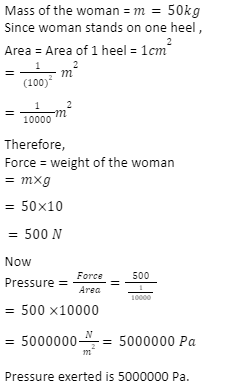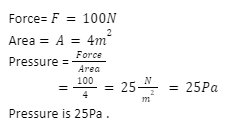Introduction
The pressure is the force acting per unit area. It varies inversely to the area. Pressure plays a vital role in determining the amount of force applied to a given area. Various objects are designed to reduce or increase the pressure applied to an object. This article aims to provide knowledge about the pressure and the Archimedes Principle.
What is Pressure?
Pressure can also be defined as the ratio of the force and the area where force is acting perpendicularly (thrust). P is used to denote pressure. It is the amount of force exerted on a given area.
The mathematical expression of pressure is:

There are four kinds of pressure. These are:
- Atmospheric pressure
- Absolute Pressure
- Differential Pressure
- Gauge Pressure.
A sharp pin vs blunt pin is the perfect example of pressure in day-to-day life. It is easier to hammer a sharper pin than a blunt pin. Sharper pin covers a lesser area and thus a small amount of pressure can exert greater force.
Archimedes Principle
Archimedes’ principle states that an object fully or partially immersed in a fluid is subjected to upthrust forces which are equal to the weight of displaced fluid. The condition is known as the equilibrium condition.
The force which is subjected to the object is known as buoyancy force. The principle stated that the object that is partially or fully immersed in the fluid experiences buoyant force equal in magnitude to the force of gravity on the displaced fluid.
Mathematical formation of Archimedes principle:

Now the fluid displaced fluid times the magnitude of the acceleration due to gravity is the weight of the displaced fluid.
Here we can write the equation as F=W, W denotes weight.
The confusion between the buoyant force and Archimedes’ principle is that sometimes people are confused between the formula of buoyant force F = ρgV refers to the displacement density fluid, not the object’s density. People also confuse the volume of the submerged object and the whole object’s volume. The buoyant force does not depend on depth. It only depends on the volume of the fluid, the density of the fluid and gravity acceleration.
Application of Archimedes Principle
- The application of Archimedes’ principle is to evaluate relative density in designing submarines and ships. In making hydrometers, lactometers etc.
- The submarine has a Buoyancy tank, which depends on the need of submarines, takes water inside and increases the weight and empties water outside and decreases the weight.
- Ships are heavier than water, but due to their unique shape, it has a large volume, so the water displaced by the ship provides them with a right upthrust so that they can float on water.
Q 1. A force of 100 N acts on an object of area 4m2. Calculate pressure.
Solution :
Q 2. A woman is wearing pencil-heeled shoes. If the mass of a woman is 50kg and the area of one heel is 1 cm2. Calculate the pressure exerted on the ground when a woman stands on just one heel.
Solution :

Q 3. When an aluminium object is immersed in a liquid, it displaces 5 kg of liquid. How much is the buoyant force acting on an aluminium object in newtons? (g=10 ms-2)
Solution:
Mass of water displaced = m= 5 Kg
According to Archimedes principle
Buoyant force acting on object = weight of liquid displaced by the object
Weight of object = m×g
= 5 10
= 50 N
Therefore,
Buoyant force = weight of object = 50 N
Q 4. A 0.650 kg garden gnome went snorkelling a little too low and found himself at the bottom of a freshwater lake of depth 35.0 m. The garden gnome is solid with no holes and takes up a total volume of 1.44 × 10-3 m3 The density of freshwater in the lake is 1000 kg m3. What is the buoyant force on the gnome?
Solution :
FB= ρVg (use buoyant force equation which is just Archimedes principle in maths form)
Now
FB=14.1 N
Conclusion
Here we discussed pressure and Archimedes’ principle, its mathematical expression and its day-to-day use in life with mathematical examples. Pressure is nothing but the force exerted in a particular area. And Archimedes’ principle states that the object is fully or partially immersed in a fluid; its volume is in equilibrium with the displaced liquid. Based on this theorem, we gave the expression of buoyant force. With the help of buoyant force, we describe the features of submarines and ships, lactometers, hydrometers etc.
 Profile
Profile Settings
Settings Refer your friends
Refer your friends Sign out
Sign out














